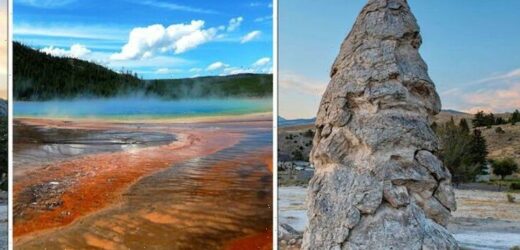Yellowstone supervolcano: Expert on ‘danger’ of Caldera in 2015
We use your sign-up to provide content in ways you’ve consented to and to improve our understanding of you. This may include adverts from us and 3rd parties based on our understanding. You can unsubscribe at any time. More info
Yellowstone is an example of one of the world’s so-called supervolcanoes — a volcano that has a Volcanic Explosivity Index [VEI] of eight, the highest value on the Index. While it is not highly active — it has erupted just three times in the last three million years — researchers have long studied the giant caldera in the Yellowstone National Park in Wyoming, US, for the potential consequences of a contemporary eruption. The last came 630,000 years ago, and was 1,000 times bigger than the 1980 Mount St Helens eruption which caused more than $1billion (£741million) in damage.
Such was the strength of its last event that a large volume of material caused the ground to collapse.
This created a Great Depression known as a caldera, measuring 55 kilometres by 80 kilometres wide.
The next eruption is predicted to have catastrophic global effects, with many of these outcomes explored during What If’s short documentary, ‘What If the Yellowstone Volcano Erupted Tomorrow?’
The narrator noted: “Right now, in the US, one of the world’s largest volcanoes is gearing up to explode.


“If Yellowstone decided to erupt, the results would be devastating.
“It has erupted three times in the past three million years which has led some people to wonder whether we should be worried about another eruption in the near future.
“But if the eruption took place tomorrow and you lived in North America, there would be virtually nothing you could do to prepare.”
While Yellowstone has a low population density — 0.2 people per square mile — the number of those living in and near the Greater Yellowstone Ecosystem has in recent years increased.
From 1990 to 2020, the number grew by nearly 50 percent, with that trend continuing.
JUST IN: Putin sends horrifying warning to West after nuclear missile launch

Luckily for those people, in geological terms, “near future” can mean hundreds of thousands of years away.
If Yellowstone does erupt, there is unlikely to be any significant lava flow, because before lava becomes lava, it is known as something called magma.
Much of Yellowstone’s magma will never turn into lava because the intensity of an eruption would force most of it to shoot into the sky, leaving much of the surrounding area escaping being scorched.
However, the magma would soon transform into airborne ash particles, which are small, scorching pieces of jagged rock.
This alone would affect more or less the whole of the US and Canada.
DON’T MISS
Yellowstone supervolcano: ‘First sign’ of imminent eruption laid bare [REPORT]
Archaeology breakthrough as metal detectorist unearths gold brooch [INSIGHT]
Heart disease: Oxford Uni finds eating veggies offers no protection [ANALYSIS]


And, more tragically, tens of millions of people within a 1,000km (621-mile) radius would die.
Once breathed in, the ash would form a cement-like mixture in the lungs, causing suffocation.
Outside, buildings would collapse as a result of the ash — just 30 cm (12 inches) of ash is enough to cave-in roofs.
Experts say that, even if you were outside the 1,000km range, you would still be in trouble.
As far away as the east coast of the US, around a centimetre of ash would have fallen, an amount still dangerous to human lungs.
Some ash would even travel to Europe, while the rest of the world would experience extreme weather changes.

The global temperature would drop by around 10°C, and this decrease could last as long as a decade.
The ash would also affect crops, water supplies and almost everything else we rely on.
Organisations like NASA have been working on solutions to prevent such a devastating event.
One thing they have looked at is increasing the amount of water within the volcano in order to extract its heat day-by-day and reduce the risk of an eruption.

Yet, in practical terms, this initiative is unlikely to gain the backing of any political body and the policy and financial aid required.
One plan NASA does have that could attract a government’s support involves drilling a 10km hole into Yellowstone and pumping water into it at a high pressure.
This would circulate the water and return it at an estimated temperature of 350C (662F), and slowly day by day extracting heat from the volcano.
Estimates suggest such a project would come at a cost of around $3.46billion (£2.69billion), but would generate electric power at competitive prices, and so comes with an enticing catch, which could convince politicians to make the investment.
Source: Read Full Article


